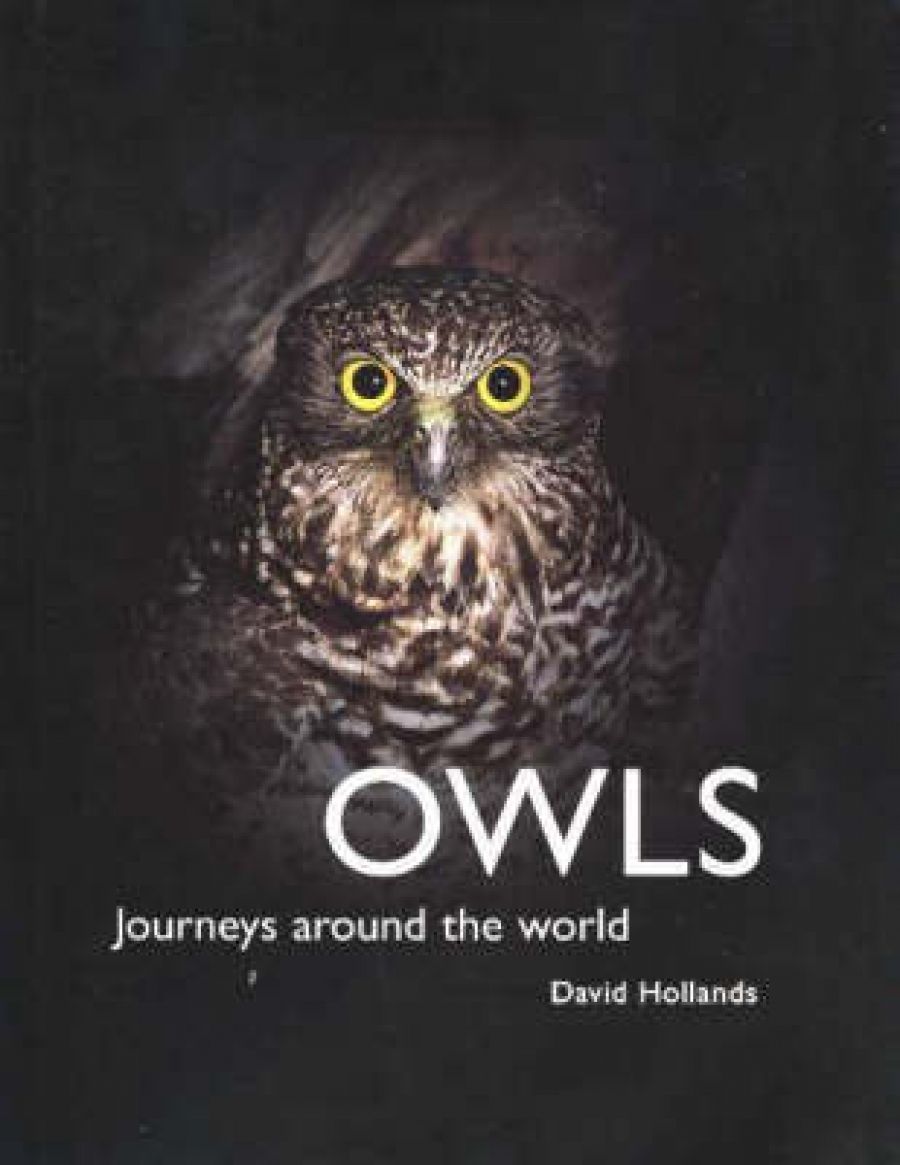
- Free Article: No
- Contents Category: Nature Writing
- Review Article: Yes
- Article Title: A Great Service
- Online Only: No
- Custom Highlight Text:
Owls have captured the human imagination as much as any group of birds. Mysterious, nocturnal hunters with haunting, far-carrying calls, silent flight, and prominent, forward-facing eyes, owls evoke a range of emotions from fear and awe to delight and a deep concern for their welfare.
- Book 1 Title: Owls
- Book 1 Subtitle: Journeys around the world
- Book 1 Biblio: Bloomings Books, $59.95hb, 245pp, 1 876473 50 9
- Book 1 Cover Small (400 x 600):

- Book 1 Cover (800 x 1200):

David Hollands was smitten by owls from an early age and for the last few decades has devoted most of his spare time to compiling a photographic record of their life history. Having completed his successful project to document all Australian species (Birds of the Night: Owls, Frogmouths and Nightjars of Australia, 1991), Hollands then expanded his horizons to pursue owls worldwide. This book presents, in words and photographs, a selection of Hollands’s owl adventures in North, South and Central America, South Africa, Europe, Japan and eastern Australia.
Owls: Journeys around the World has been designed to display the magnificent photographs to best effect. However, the spare and evocative text is also a valuable and passionate statement about the lives of owls and the threats to owl populations, and an inspiring summary of the work of a handful of devoted ornithologists who are working to overcome those threats. Reading it, I was reminded of the impact on this then fledgling field naturalist of David Fleay’s Nightwatchmen of Bush and Plain (1968), surely a classic of Australian natural history. Hollands’s book could have a similar impact on young naturalists worldwide.
Of course, a book such as this cannot cover all of the world’s 150-odd species of owl. Instead, Hollands presents a selection of twenty-one of his favourite species, some of which he had dreamt of meeting for decades. This passion shines through in the writing and the skilful photographs. Bird photography is a specialised and exacting field. Photographing wary, nocturnal birds, sometimes from a hide perched precariously thirty metres high atop a prefabricated tower, is perhaps the most challenging form of bird photography. Hollands is amongst the best photographers of nocturnal birds, providing rare glimpses of the lives of these little-known species.
Just as interesting as the owls are the descriptions of the owls’ champions, including the wonderfully charismatic Finnish opera singer and ornithologist Pertti Saurola. Saurola has been instrumental in a programme to provide alternative nest sites for owls that formerly nested in tree hollows in old-growth coniferous forests. Following intensive timber harvesting, a lack of hollows in the regrowth forests severely limits populations of hollow-dependent fauna, including several species of owls. In response, the redoubtable Finns have installed many thousands of nest boxes which are used by several owl species, and upon which the Ural Owl is now almost totally dependent.
Even more evocative are the photographs. Many show birds at their nests delivering prey to their young; others are at roost in trees, or on the ground in the case of Argentina’s diminutive Burrowing Owl; and some are in full flight, launching fearsome attacks on the observer. Favourites include immaculate Snowy Owls on the Alaskan tundra, the persecuted but defiant Eagle Owls perched on a cliff overlooking the Danube in Austria, the endearing Christmas Island Hawk Owls in their dark rainforest home, Blakiston’s Fish Owls expertly relieving Hokkaido streams of their trout, and Victoria’s magnificent Powerful Owl staring haughtily from a Cherry Ballart festooned with raindrops.
Hollands’s data on the poor reproductive success of Powerful Owls in the box-ironbark forests of central Victoria are disturbing. As he suggests, they probably reflect the impacts of past clearing leaving a disjointed and fragmented habitat. Population persistence in such landscapes may always be precarious. However, elsewhere in Victoria, there is evidence of a welcome resurgence, with, for example, increasing reports of Powerful Owls in suburban Melbourne, presumably dispersing juveniles from successful pairs in the forests to the north-east.
However, as the last chapter succinctly shows, the threats to owl populations are legion and ubiquitous. The survival of many species will depend on the efforts of conservation champions such as Hollands and his friends. By producing this eloquent book, which is much more than a picture book, Hollands has done the owls of the world a great service.


Comments powered by CComment